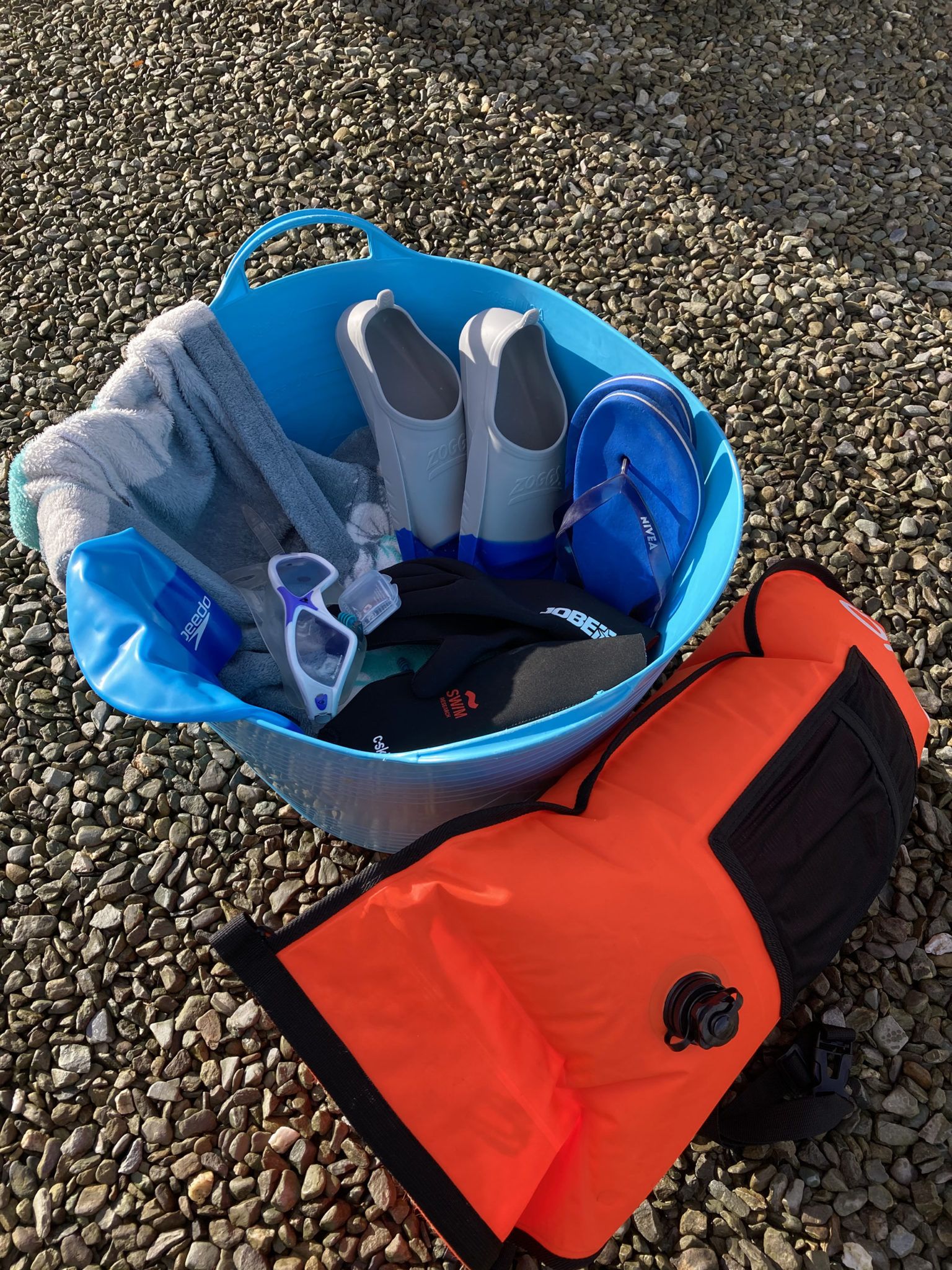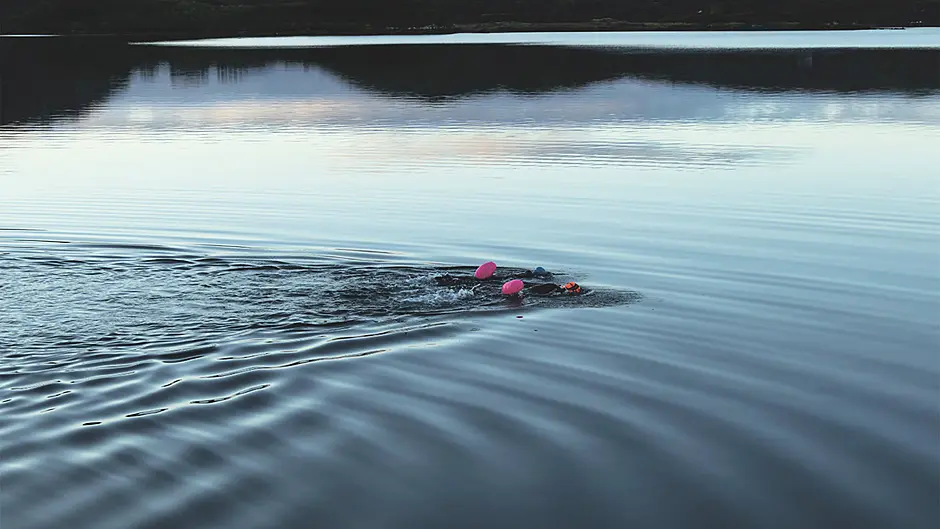‘DON’T ride any horses, don’t fall off any tables, and maybe don’t ski for a while.’
Those were the recommendations from my surgeon after my back operation some years ago – to treat a slipped disc which I suspected had come about after a rather unyielding encounter with a tree in the Alps.
The first piece of advice was a general one for anyone recovering from major back surgery, and the second referred to his previous patient, who had been dancing on a table (in celebration, no doubt) a week after her own operation, and found herself back under the scalpel after that.
Not being a fan of scalpels myself, I opted to take all three pieces of advice, but I was worried my life would be totally devoid of fun, as a result.
What exactly can I do? I asked him.
‘Swimming and yoga seem safe enough,’ he replied. That’s what he thought.
Several years on and I have migrated from the safety of lengths in a pool, to full-on open sea swimming, all year around.
And I have been known to dabble in the odd acro-yoga class, too – but that’s another wobbly story entirely.
I reluctantly started swimming classes a few weeks after my operation, having being self-taught on a summer holiday in Cobh in my youth. I could just about stay afloat but I had no great grace, or interest.
But once I committed myself to the weekly class at my Dublin gym, I realised I better justify the fees. And within a few hours of my first pool dip, I was hooked. I discovered that I loved water.
And once I got the hang of staying afloat, I ditched my trainer and started working on my stamina, adding two new lengths every week. In a year I just wanted enough time to do 60 lengths, and I genuinely looked forward to my thrice-weekly sessions.
It wasn’t until my move to West Cork, though, ten years ago, that the idea of doing any kind of regular sea swimming, came to mind. The pristine waters, endless choice of coves, lakes, and white sandy beaches made it hard to resist.
I met some friends in my local pool who transferred to the sea that March and so I agreed to join them. Don’t be fooled by the enthusiasm of sea swimmers into thinking that it feels wonderful from the off.
Those first few moments of cold water rushing over your skin is not always the most pleasant sensation, but the certain knowledge – borne out of eventual experience – that this will soon pass, and the adrenaline surge will kick in, makes it all worth it. And us weathered swimmers know all the tricks now: Have loads of warm, cosy clothes ready to get into. Don’t bring anything itchy, tight-fitting or nylony – stock up on loose long-sleeved t-shirts, baggy fleeces, soft jumpers, woolly hats and loose socks, and a flask for warm (not hot) drinks.
Some people fill a 2 litre bottle with warm water to pour over their chilly bodies after the dip, others bring hot water bottles. I have a selection of microwaveable ‘hot packs’ that I wrap several towels around so they keep the heat for up to an hour.
Sea swimming is a bit like the Marmite of hobbies – you will either take to it instantly, or run away screaming wondering what all those freaks are on about.
Don’t feel bad if you decide it’s just not for you, but if you do get hooked, be prepared to bore all your friends and family for years to come on the benefits of salt water – good for the mind, body, skin, soul and a great calorie-cruncher.
So let’s say that’s the first summer over. You’ve dipped and bobbed about, but next year you might want to take it a step further and use it as your regular exercise regime.
Well that will enquire a bit more equipment and definitely more commitment.
Early mornings are the best times to get going and there’s nothing like the joy of watching the sun rise while you are immersed in God’s own bath.
If you have been so bitten by the bug that you want to keep it going all winter, then invest in the proper gear (see panel). And make sure you have found like-minded souls, so you never need to go it alone. You will probably need to embrace social media for this, if you don’t already have willing friends to join you in your madness.
There are loads of local swimming groups all around the coast, and inland, too, for the lakers.
‘Wild Swimming – Ireland’ on Facebook is one of the best resources for newbies, and has some great chats about locations, techniques and equipment, if you scroll through.
But take it in small steps – a little bit longer, a small bit further, each day. Always swim horizontal to the shore, only on locally-proven safe beaches, and never alone.
It’s worth travelling a distance to be able to enjoy the camaraderie and safety that a local swimming group will give you. Swimmers love to ‘spread the word’ and will always welcome newbies – for conversion to the immersion!
So, best neoprene-d foot forward, and enjoy!
Siobhán’s guide to the essential swimming gear
 Some of the items in Siobhan's everyday tub.
Some of the items in Siobhan's everyday tub.Swimming wetsuits: These are really worth it if you are going to be in for any length of time, apart from during the height of summer, perhaps. But they are also great protection from jellyfish. Swim wetsuits are specially designed to help you glide through the water, are lighter under the arms, and are very fragile so do use the cotton gloves if your suit comes with a pair. They take a bit of patience getting on and off, but they should feel like a second skin so it’s worth the hassle. From about €160 but the best investment you will make as a swimmer. Shops will advise on the best ones, based on skill and objectives.
Socks: Swimming socks come in various thicknesses, and give extra warmth as well as protection from sharp stones. From about €15.
Gloves: Similar to socks, and similar in price, it is advisable to get a pair once the autumn sets in.
Caps: A great tip is to wear two caps at once – you lose so much heat through your head. From €10 up.
Goggles: They should clasp snugly to your face without having to be over-tightened, as the suction should do the work rather than the strap. A bit of spit on the lens will stop them fogging up (yeuch, but true) and you might need to invest in a few before you find the perfect fit. From about €15 up, a really good pair will probably set you back about €25.
Ear-plugs: Regular cold water swimming can cause ear-ache and complications. It can also throw you off balance when you come in to shore. Invest in reusable plugs – they have the added bonus of keeping your inner ears warm. From €5 up.
Snorkels: A snorkel takes the stress out of breathing but it’s also worth investing in one-on-one lessons so you can eventually ditch it, giving you more confidence and agility. From about €20 up.
Fins: Fins for your feet will give you an extra edge on distance and are good in rougher water, though they take a bit of getting used to, as your legs move differently in them. From about €15 up. Not advisable for newbies.
Floats: For safety and visibility, an inflatable high-vis float is essential for sea-swimming. It ties to your waist and floats behind you. You won’t notice it, but others will. They cost about €20 and are also a great buoyancy aid if you run out of steam. More expensive ones let you put keys etc inside.
Swimming capes: This summer’s must-have item was the DryRobe but there are many other brands of lined fleece coats for post-swimming warm-ups. Fleece capes are available from about €50, while the coats are usually over €150.
Flask: A traditional tea flask, from about €15, is well worth the money to get your core warmed up again.
Smart watches: When you really start to get serious and want to track your distance, heart rate and stroke efficiency. Starting at around €150, should probably be the last accessory on your ‘essential gear’ list!
Top tip
Before you start buying the non-essential items, invest in a few one-on-one lessons. Try and get a coach who sea- swims themselves and can spot any technique issues. You will never regret that investment.
Viewing tip
There are loads of great resources online for techniques. I have found Australian coach Brenton Ford’s Effortless Swimming site on Youtube is a great resource for videos.







